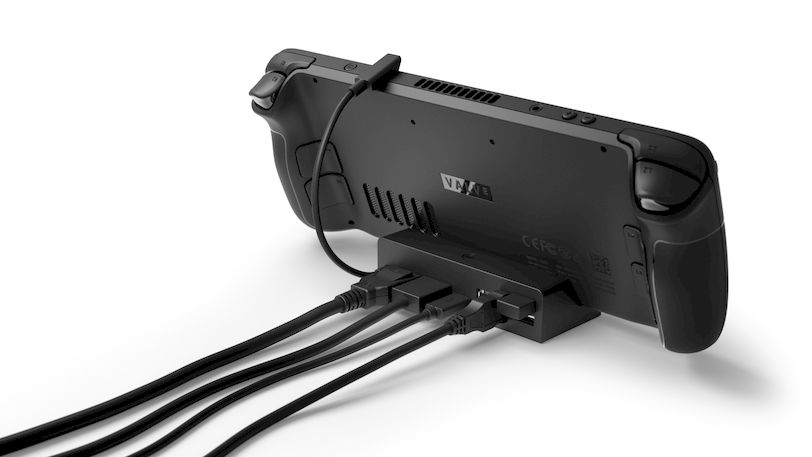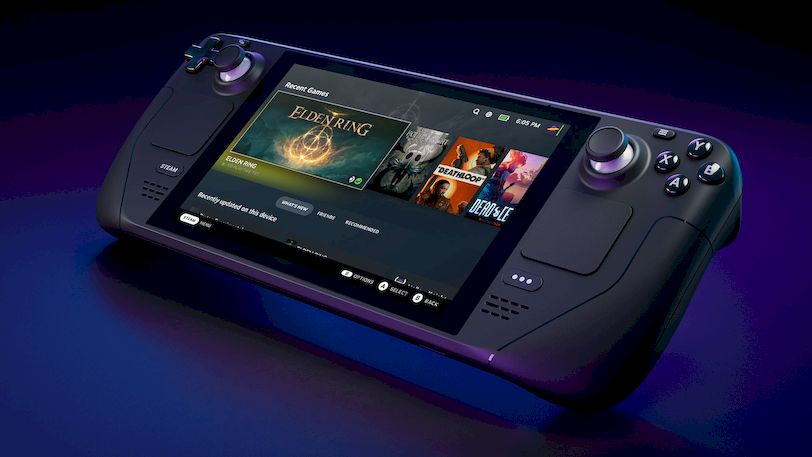What are the Steam Deck specs?

Valve’s Steam Deck is the most anticipated “gaming handheld” on the market. And despite its small size comparable to a portable console, it promises to deliver sensational performance, a great user experience and a low price. In this article, we will tell you all about this impressive PC gaming concept.
What is Steam Deck?
To understand what Steam Deck is, let’s talk about Valve first. Founded by Gabe Newell, this company has Steam as one of its main dedications. They are the creators of the most important distribution platform for PC games in the world.
They are also responsible for legendary games such as Half-Life, Counter-Strike or Portal. But be careful, because there is another aspect that not everyone knows about: hardware development. You may not be familiar with the Steam Controller or the Steam Link device, but you are certainly familiar with the HTC Vive. These virtual reality glasses were developed by both HTC and Valve.
One of Valve’s biggest failings was the Steam Machine concept, which are basically prebuilt computers similar in size to a console, designed to run the SteamOS system and the Steam Controller. The market reaction was depressing and there is no Steam Machine anymore.
It was in this context that Steam Deck was born, and in this case the idea is to leverage what’s left of the Steam Machine to create a PC with the body and functions of a portable console, meeting the needs of users who want all the features.
So far, no “handheld” on the market has received much attention, and the small consoles segment has moved on via the Nintendo Switch and nothing else. Steam Deck has come to change that powerfully.

Steam Deck Specifications
Now we will see the most important technical features of Steam Deck and then we will comment on the most important ones.
- Processor: AMD APU Zen 2 4c/8t, 2.4-3.5 GHz (up to 448 GFlops FP32)
- Video card: 8 RDNA 2 CUs, 1.0-1.6 GHz (up to 1.6 TFlops FP32)
- APU power: 4-15 W
- Memory: 16 GB LPDDR5 onboard memory (32-bit quad channel, 5500 MT/s)
- Storage options: 64GB eMMC (PCIe Gen 2 x1) – 256GB NVMe SSD (PCIe Gen 3 x4) – 512GB high speed NVMe SSD (PCIe Gen 3 x4)
- Expansion: All models use plug-in 2230 m.2 modules (not designed for end-user replacement). All models have a high-speed microSD card slot. UHS-I; Supports SD, SDXC and SDHC.
- Resolution: 1280 x 800 pixels (16:10 aspect ratio)
- Screen type: Optically bonded IPS LCD for enhanced readability
- Screen size: 7 inches (diagonal)
- Brightness: 400 cd/m² (typical value)
- Refresh Rate: 60 Hz
- Touchscreen: Yes
- Sensors: Ambient light sensor
- Game controller controls: A B X Y buttons, Arrow keys, Right and left analog triggers, Right and left upper buttons, View and Menu buttons, 4 x assignable grip buttons, Analog sticks, 2 x full size analog stick with capacitive touch, HD haptic, 2 x 32.5mm square touchpad with haptic feedback, 55% less lag compared to Steam Controller, Pressure sensitivity for adjustable click force
- Gyroscope: 6-axis inertial measurement unit (IMU)
- Bluetooth: Bluetooth 5.0 (supports controllers, accessories and audio enhancements)
- Wi-Fi: Dual-band Wi-Fi, 2.4 GHz and 5 GHz, 2 x 2 MIMO, IEEE 802.11a/b/g/n/ac
- Audio channels: Stereo with embedded DSP for an immersive audio experience
- Microphones: Dual microphone array
- Headphone/microphone jack: 3.5mm stereo headphone jack
- Digital audio support: Multi-channel audio via USB-C via DisplayPort, standard USB-C or Bluetooth 5.0
- Charging port: USB Type-C PD3.0 power supply at 45W
- Battery: 40 Wh battery (2 – 8 hours of playtime)
- External connection for controllers and displays: USB-C port compatible with DisplayPort 1.4 Alt-mode; up to 8K @ 60 Hz or 4K @ 120 Hz, USB 3.2 Gen 2
- Size: 298 x 117 x 49mm
- Weight: Approx. 669 grams
- Operating system: SteamOS 3.0 (based on Arch)
- Desktop: KDE Plasma
Powerful processor and video card
The Steam Deck APU was developed by AMD specifically for Valve. It uses a 4-core, 8-thread Zen 2 processor that is comparable to the Ryzen 4300GE, despite having an even lower frequency.
It’s not a great CPU for gaming due to its frequency, but that’s what you can expect in such a small body.
As for the graphics card, RDNA 2 is AMD’s newest architecture, and the use of 8 CU points refers to basic graphics, but it’s better than what’s used in desktop APUs. According to Valve, Steam Deck will run any Steam game at 30 FPS or higher, depending on the game.
Storage options
There are 3 different storage options: 64GB eMMC or 256/512GB NVMe. The difference in performance between these two technologies is incredible, as NVMe is used in high-end computers, while eMMC is used more in low-end mobile phones.
Without hard performance data at hand, the NVMe options appear to be by far the best.
The problem with expanding the storage on the Steam Deck is that it uses an M.2 2230 slot. This is basically the smallest M.2 type, so its market availability is really low.
For example, practically all we find is on Dell’s official website at a fairly high price.

Is the screen resolution low?
As we can see, the screen resolution of the Steam Deck is 1280×800, which is equivalent to 720p resolution, but in 16:10 format. So, it’s probably not a Full HD display as you might expect from the very beginning.
Is it a problem? No really. If we take into account the screen size of the Steam Deck, we have a density of 215 ppi (pixels per inch). A 24-inch 1440p monitor has 120 PPI, a 22-inch 1080p monitor has 100 PPI, a 1080p 14-inch laptop has 160 PPI, etc.
More resolution would affect performance with no clear benefit in image quality.
That is, despite the “low” resolution, the pixel density exceeds almost any device we have except our mobile, so we would not notice more pixels than on a regular computer monitor and stream.
However, if the resolution was increased to 1080p, it would affect the price and most of all, it would force the APU used, sacrificing the graphics performance, and the visual benefit would be greatly reduced. Valve has been completely successful with the resolution of the Steam Deck.
Battery, connection and size
Let’s continue talking about the battery. The device has a capacity of about 40 Wh, which is on par with much larger laptops, so this is quite an achievement. Still, according to Valve, it’s enough to give you 2 to 8 hours of usage, 2 hours is too little, 4 hours is “ok” and 8 hours is great. It’s not entirely clear how much you can play with the Steam Deck, though.
We only have one USB Type-C input and 1 audio jack as ports. Note that we can take advantage of the USB-C connector with DP Alt Mode 1.4, which basically allows us to connect a secondary display to our Steam Deck.
Finally, the dimensions of the equipment are 298mm x 117mm x 49mm and it weighs around 669 grams. A little heavy but not bad.
Steam Deck Releases, Discounted Prices and Availability
After thoroughly analyzing the Steam Deck specifications, it’s worth checking out what are the different options we can buy.
We’ve already explained that the main difference is in storage, but we’ll see what the prices are and what else will change.
- 419 Euros in the simplest option with 64GB eMMC and carrying case.
- 549 Euros total with 256GB NVMe and the exclusive Steam Community Profile bundle.
- With 512GB NVMe, “premium anti-glare display”, a different carrying case than the other two options, a special profile pack, plus a “special themed virtual keyboard” for a total of 679 euros.

And which of these options is the best in terms of value for money? The fact is that the advantages offered by the most expensive version do not seem so significant: paying 130 € more to double the GB is quite high, while the anti-reflective screen does not seem so significant.
It’s best to go straight to the intermediate version. Good price and fast storage. The capacity of the eMMC version is somewhat insufficient, and the performance of such storage is poor.
Steam Deck will start selling to users who pre-order only from December 2021. Now we explain how to book and why you should.
To reserve the Steam Deck, you must now go to the official Steam website where you will find the versions we just mentioned with the reserve button. By the way, you must have a relative in the USA or Europe to make the reservation, because this cannot be done in Turkey.